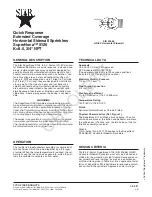
12
Select the RS-485 COM port to be used from the
TM-2000/MTM-2000 to each intercom system.
The COM port can be changed by right clicking
anywhere along an intercom system’s entry in the
table. A pop-up menu will display. Select the
correct COM port by moving the pointer to the
Select COM Port
entry and clicking on the
desired COM port.
Send the changes to the TM-2000/MTM-2000
and save the file.
6.
Click the bar labeled
Trunk
on the left side of the
screen and then click the Definitions icon. A table
displaying trunk definitions will be displayed. On
initial setup this table will be empty. Do the
following:
Right-click on a trunk entry under the
Icom 1
column. Select
Choose New Assignment
from
the pop-up menu that appears. Select the
intercom system that is desired for this end of the
trunk line. Repeat the same for the
Icom 2
column in the same line except choose an
intercom system different than that selected for
Icom 1
. This defines which two intercom systems
(
Icom 1
and
Icom 2
) will be trunked via this entry
in the table.
Right-click in either the
Port
or
Alpha
entry
associated with the
Icom 1
entry you just made
and select the
Choose New Assignment
from
the pop-up menu that appears. Select the
Port
or
Alpha
to be used for the audio trunk line from the
system named in the
Icom 1
column. Do the
same for the
Port
or
Alpha
entry associated with
the
Icom2
entry except select the
Port
or
Alpha
from the
Icom 2
system for the audio trunk line.
If this particular trunk line is to be cascadable (i.e.
usable to connect two other adjacent systems),
then be sure to set the
Cascade
flag. To set or
clear the
Cascade
flag, right-click on the
Cas-
cade
entry for the trunk line and select
Set
Cascade Flag
or
Clear Cascade Flag
from the
pop-up menu that appears.
Repeat this procedure for each intercom system
audio trunk line that will be needed. When
finished send the changes to the TM-2000/MTM-
2000 and save the file.
7.
Run
AZedit
. Within each intercom system,
assign keypanel keys as required to communicate
with destinations in other intercom systems. This
is similar to assigning keys in the local intercom
system, except that you will have to select an
intercom system first when making assignments.
Click the
KP
button on the toolbar to access
keypanel setup. Then, select the intercom port
where you want to add a key assignment that will
communicate with a remote intercom system. If
you use the
Key Assignment Select
screen to
assign keys, proceed as for normal key assign-
ment, except that you should select an intercom
system before selecting a scroll list. Press the F1
key on the computer keyboard to get help on
keypanel setup.
Be sure to send your changes to the intercom
system and save the file before exiting
AZedit
.
Specifications
TM-2000
Height: ....................................... 5.25” (133.35mm)
Width: ........................................ 19.0” (483mm)
Depth: ........................................ 18.5” (470mm)
Weight: ...................................... 48.7lbs (22.1kg)
Power: ....................................... 115/230 VAC
(switch selected),
50/60 Hz. 2.6A
MTM-2000
Height: ....................................... 3.50” (88.9mm)
Width: ........................................ 19.0” (483mm)
Depth: ........................................ 19.5” (495.3mm)
Weight: ...................................... 23.12 lbs (10.48kg)
Power: ....................................... 115/230 VAC
(switch selected),
50/60 Hz. 2.6A
SWP-2000
Height: ....................................... 1.75” (44mm)
Width: ........................................ 19.0” (483mm)
Depth: ........................................ 5.3” (133mm)
Weight: ...................................... 5.2lbs (2.4kg)
Power: ....................................... 100-240 VAC, 47-63
Hz, 0.4 A
I
CP-2000
Height: ....................................... 1.75” (44mm)
Width: ........................................ 19.0”” (483mm)
Depth: ........................................ 1.0” (25.4mm)
Weight: ...................................... 5.2lbs (2.4 kg)
Environment
Operating Temperature .............. 0° C to 50° C (32° F
to 122° F)
Storage Temperature ................. -20°C to 75°C (-4° F
to 167° F)
Humidity .................................... 0 to 95% non-
condensing
Approvals
UL, FCC, CE
Содержание ICP-2000
Страница 2: ...2 This page intentionally left blank ...
Страница 4: ...4 This page intentionally left blank ...
Страница 6: ...6 This page intentionally left blank ...
Страница 15: ...15 Figure 10 Example of a non redundant TM 2000 system ...
Страница 16: ...16 Figure 11 Example of a redundant TM 2000 system ...
Страница 22: ......








































